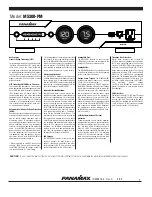
“OK” to operate
(but replace) zone
Figure 82. Gauge needle in yellow “OK” to operate (but replace) zone.
OK to operate (but replace):
This is the yellow zone. If the gauge needle is
in this zone, the pole-unit can be opened and
closed with full ratings. However, the pole-unit
has lost gas and should be replaced as soon as
possible. See Figure 82.
Ç
WARNING
DO NOT open Trans-Rupter II unless the gas-
pressure gauge is in the “OK” to operate zone .
Opening Trans-Rupter II with one or
more pole-units in the “Do not operate”
zone can damage the transformer.
“REPLACE” zone
Figure 83. Gauge needle in red “REPLACE” zone.
REPLACE:
There are two red zones. If the indicator needle
is in the red zone shown in Figure 83, the gas
density in the pole-unit has dropped below the
minimum functional level and the pole-unit
will not maintain full interrupting or dielectric
ratings. The pole-unit should be removed from
service and replaced promptly. Do not operate
this Trans-Rupter II.
Indicators
If the indicator needle is in the red zone
shown in Figure 84, the local gas-density
gauge is damaged, and cannot be relied on to
provide an accurate indication of gas density.
The pole-unit should be removed from service
and replaced promptly. Contact your local S&C
Sales Office. Do not operate the Trans-Rupter II.
NOTICE
At temperatures below -31°F (-35°C), a Level
2 alarm may be issued due to the cold temper-
ature . The gas density is below the minimum
functional level, so the pole-unit will not have
full interrupting or dielectric ratings .
At these
temperatures, a Level 2 Alarm does not
accurately indicate whether a pole-unit is
losing SF
6
.
“REPLACE”
zone
Figure 84. Gauge needle in red “REPLACE” zone.
S&C Instruction Sheet 731-502
41

























